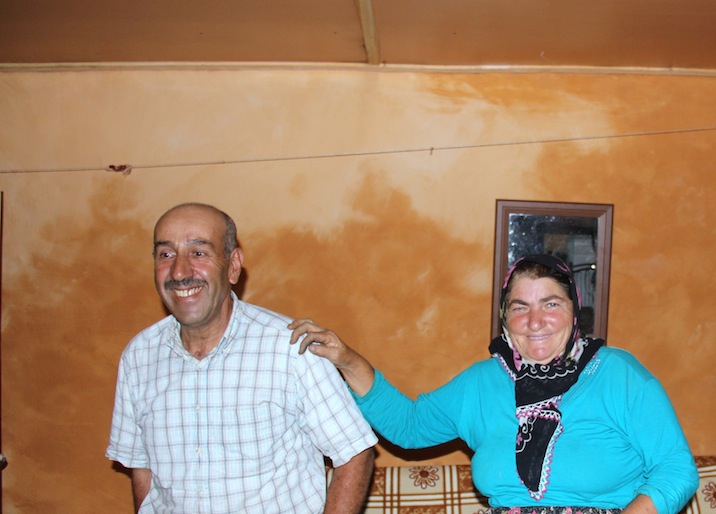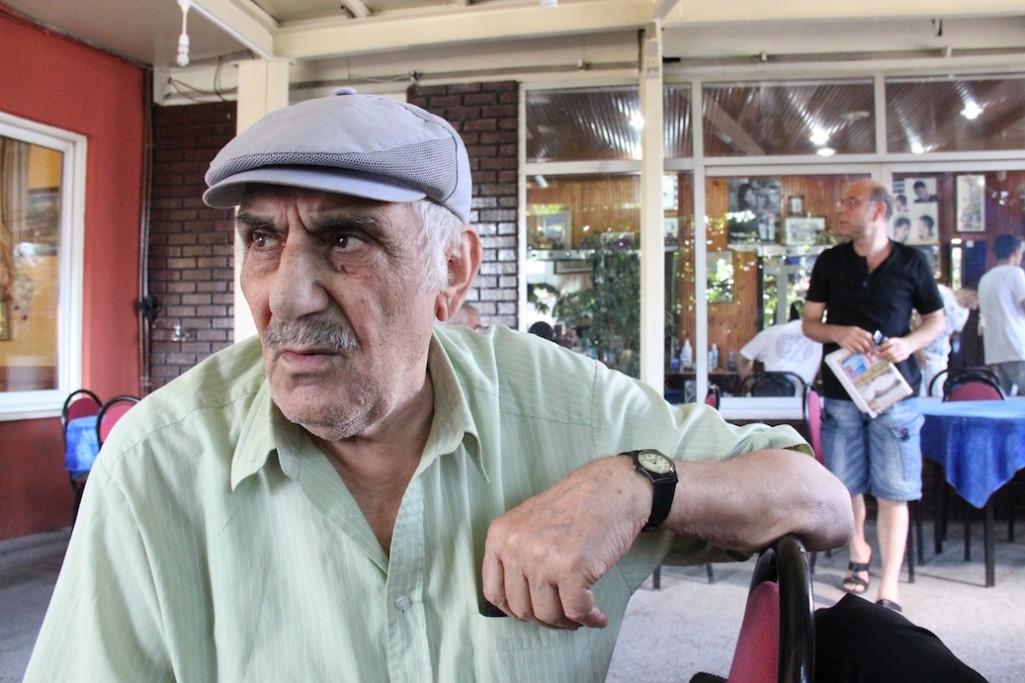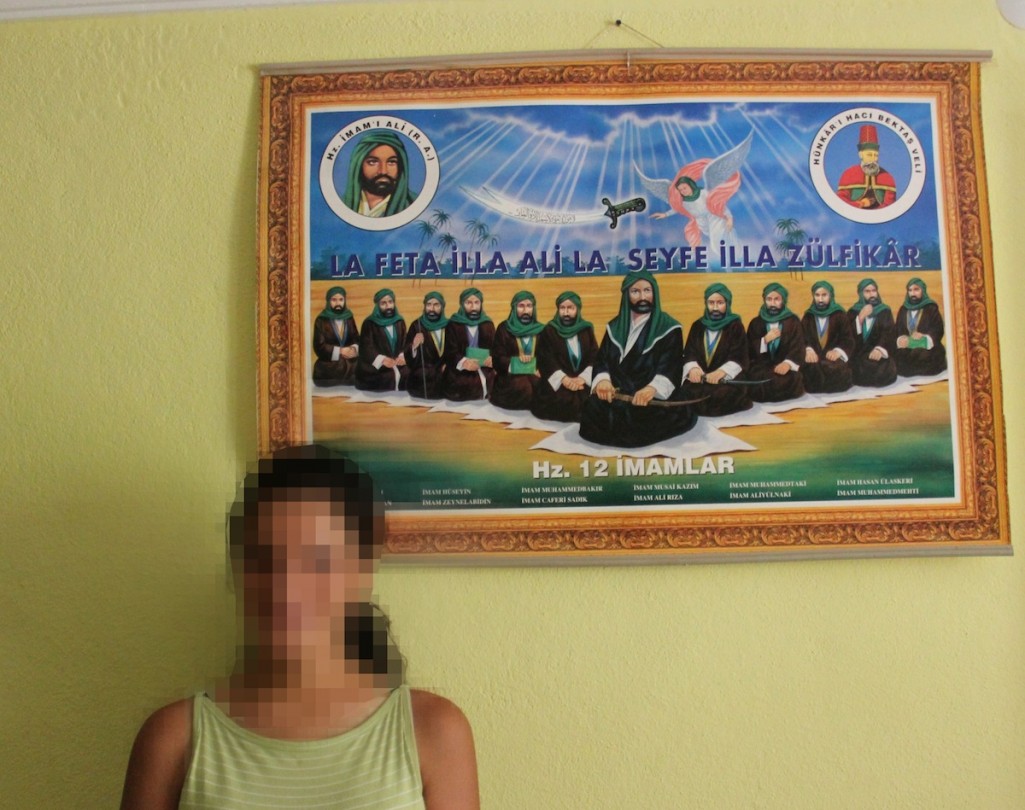A Lost Map on the Tramway in Istanbul (about Secret Armenians in Turkey)
A Lost Map on the Tramway in Istanbul
“Who are you? This is Turkey. Do you know what Turkey is?” a man asked me, his thick glasses magnifying the fear in his eyes. He belonged to the little-known Armenian Gypsy community, in the Kurtuluþ district of Istanbul. I was at a teahouse where Armenian Gypsy men usually gathered, trying to interview them.
And he was right. I didn’t know what Turkey is. But Turkey, and many Armenians themselves, didn’t know who he was either.
In Turkey, there lives a mysterious minority known as the “secret Armenians.” They have been hiding in the open for nearly a century. Outwardly, they are Turks or Kurds, but the secret Armenians are actually descendants of the survivors of the 1915 Genocide, who stayed behind in Eastern Anatolia after forcibly converting to Islam. Some are now devout Muslims, others are Alevis –generally considered an offshoot of Shia Islam, even though that would be an inaccurate description by some accounts–, and a few secretly remain Christian, especially in the area of Sassoun, where still there are mountain villages with secret Armenian populations. Even though Armenian Gypsies wouldn’t strictly qualify as Secret Armenians, they share many traits with the latter, including reluctance or fear to reveal their identity even to fellow Armenians.

Mehmet and Fatih Arkan, Muslim Armenians from Diyarbakir. Ten years ago, he would still fear to admit he was Armenian, “but now it’s no longer unsafe in Diyarbakir,” Mehmet says./ © A. Hadjian
No one knows whether the secret Armenians are in the thousands or the few million. For the most part, they fear coming out. “Turkey is still a dangerous place for Armenians,” one secret Armenian woman from Palu told me.
The secret Armenians do not mingle with the other, “open” Armenians, of the active but dwindling community in Istanbul. Most don’t talk to strangers. Breaking taboos in Turkey can be deadly. After all, they remember what happened to Hrant Dink. Dink, an Armenian-Turkish journalist, was shot dead in Istanbul in 2007 by a young man, enraged by his unforgiving pen on controversial issues ranging from the Armenian Genocide to modern Turkey’s founding father, Kemal Atatürk.
It is not easy to define who is a secret Armenian. Some refuse to be called Armenian, even though they admit their parents or grandparents were so, but sometimes, often against their own will, they are still considered Armenian by other Turks or Kurds, unconvinced about their conversion. Some are known to be Armenian to their neighbors and don’t hide it, while others keep it even from their own children, some of whom find out from other kids, who taunt them for being Armenian.
Rafael Altýncý, the last Armenian in Amasya, was raised a Christian and for one year studied in Istanbul at the Üsküdar Surp Haç Armenian High School, where Hrant Dink was also a student at the time. For all practical purposes however, he’s a Muslim and is married to a Turkish woman, with whom he has had a daughter raised as a Turk. Still, he considers himself an Armenian.
The secret Armenians do not mingle with the other, “open” Armenians, of the active but dwindling community in Istanbul. Most don’t talk to strangers. Breaking taboos in Turkey can be deadly. After all, they remember what happened to Hrant Dink. Dink, an Armenian-Turkish journalist, was shot dead in Istanbul in 2007 by a young man, enraged by his unforgiving pen on controversial issues ranging from the Armenian Genocide to modern Turkey’s founding father, Kemal Atatürk.
It is not easy to define who is a secret Armenian. Some refuse to be called Armenian, even though they admit their parents or grandparents were so, but sometimes, often against their own will, they are still considered Armenian by other Turks or Kurds, unconvinced about their conversion. Some are known to be Armenian to their neighbors and don’t hide it, while others keep it even from their own children, some of whom find out from other kids, who taunt them for being Armenian.
Rafael Altýncý, the last Armenian in Amasya, was raised a Christian and for one year studied in Istanbul at the Üsküdar Surp Haç Armenian High School, where Hrant Dink was also a student at the time. For all practical purposes however, he’s a Muslim and is married to a Turkish woman, with whom he has had a daughter raised as a Turk. Still, he considers himself an Armenian.

Rafael Altinci, the last Armenian of Amasya, at home with his wife./ © A. Hadjian
In the mountains of Mush, Jazo Uzal is the last Armenian in the Armenian village of Nish, four hours of tortuous drive from Bitlis. Mr. Uzal remains a practicing Christian, spending the winters in Istanbul, but back in the village he observes the Muslim feasts, including the Ramadan.
For his part, Mehmet Arkan, a lawyer in Diyarbakir, didn’t know his family was Armenian until he got into a fight with a Kurdish kid when was 7 years old and came back home crying, saying he had been called “Armenian.” He soon found out from his father that they were indeed Armenian, though telling anyone outside home was strictly forbidden.
“Ten years ago we would not admit it, but now it’s no longer unsafe in Diyarbakir,” he said in an interview, as the local government is embracing its Armenian past, recently restoring the St. Giragos Church and instituting a course in Armenian for beginners. Mr. Arkan feels no less Armenian for being an observant Sunni Muslim.
As my trip in search of secret Armenians was drawing to a close last summer, I experienced a final incident that shed new light on the characters that play out the drama of Turkey every day, a reminder that we are all actors trapped in the plot of history, playing roles most of us haven’t chosen.
For his part, Mehmet Arkan, a lawyer in Diyarbakir, didn’t know his family was Armenian until he got into a fight with a Kurdish kid when was 7 years old and came back home crying, saying he had been called “Armenian.” He soon found out from his father that they were indeed Armenian, though telling anyone outside home was strictly forbidden.
“Ten years ago we would not admit it, but now it’s no longer unsafe in Diyarbakir,” he said in an interview, as the local government is embracing its Armenian past, recently restoring the St. Giragos Church and instituting a course in Armenian for beginners. Mr. Arkan feels no less Armenian for being an observant Sunni Muslim.
As my trip in search of secret Armenians was drawing to a close last summer, I experienced a final incident that shed new light on the characters that play out the drama of Turkey every day, a reminder that we are all actors trapped in the plot of history, playing roles most of us haven’t chosen.
I was heading to the Istanbul Airport, where my flight to New York awaited me. I took the metro, and I got off at Lâleli Station for my transfer. After a ten-minute walk, I learned that I had disembarked at the wrong station. Then, trying not to panic, I

An Armenian Gypsy (not the one quoted in the story) at a teahouse in Kurtuluþ, Istanbul./ © A. Hadjian
also realized that I had left a four-foot tube on the tram, wrapped in old newspapers, containing valuable and potentially troublesome material: a map of Tünceli, a rebellious province, with the name “TÜRKÝYE” torn off. Inside the cylindrical tube, I had also placed compromising notes written in Turkish of an interview with a Zaza activist. (Zazas are a branch of the Kurdish people who are in the majority in Tünceli.) But what I really wanted was what I had rolled inside the map: four precious, autographed photos by Armenian-Turkish photo-reporter Ara Güler.
I debated whether I should try to recover the tube. I knew that should anyone unwrap the map, the contents could get me into trouble with the police. I was also aware of how slim the chances were of getting back an item lost in the mass transit system of a city of 13 million people.
I debated whether I should try to recover the tube. I knew that should anyone unwrap the map, the contents could get me into trouble with the police. I was also aware of how slim the chances were of getting back an item lost in the mass transit system of a city of 13 million people.

Secret Armenian pilgrims at Mt. Maruta, Sassoun. The young girl was scared when I approached her after seeing the embroidered Armenian cross in her bag, which she turned to the other, blank side. "We are Muslim," said her mother, when asked whether they were Armenian./ © A. Hadjian
The map of Tünceli had been given to me by the Zaza activist, who had torn off the name of Turkey from it –fragments from the E in “TÜRKÝYE” were still visible at the bottom of the map, looking like stripes of a tattered flag. The name of Tünceli had been angrily crossed out in thick, black sharpie, and atop it the activist had written the province’s old name, Dersim. “Dersim is not Turkey,” the activist said.
Turks mention “Dersim” and “1938” in the same breath, the way people elsewhere speak of the Olympic Games. Nineteen thirty-eight was the year of a massacre by Turkish military forces sent to suppress an uprising. Although Prime Minister Recep Tayyip Erdoðan had recently apologized for the massacre, calling it “the biggest tragedy in our history,” the name “Dersim” still has subversive resonances. Any Turkish police officer looking at the defaced map would have no difficulty getting the point. And it would easily pass for an “insult to the Turkish nation,” as defined in Article 301 of the Turkish Penal Code, punishable by up to three years in prison.
But that was small beer compared to what the notes revealed. During an interview conducted in a building facing the Turkish military base in Dersim, this Zaza activist had told me, as recorded in the notes:
“You are Armenian. This land has been waiting for you. Come and claim back your land. Get a gun, and go to the mountains to fight. If your wife doesn’t join you, we’ll get you one of our women, and she’ll fight alongside you.”
Turks mention “Dersim” and “1938” in the same breath, the way people elsewhere speak of the Olympic Games. Nineteen thirty-eight was the year of a massacre by Turkish military forces sent to suppress an uprising. Although Prime Minister Recep Tayyip Erdoðan had recently apologized for the massacre, calling it “the biggest tragedy in our history,” the name “Dersim” still has subversive resonances. Any Turkish police officer looking at the defaced map would have no difficulty getting the point. And it would easily pass for an “insult to the Turkish nation,” as defined in Article 301 of the Turkish Penal Code, punishable by up to three years in prison.
But that was small beer compared to what the notes revealed. During an interview conducted in a building facing the Turkish military base in Dersim, this Zaza activist had told me, as recorded in the notes:
“You are Armenian. This land has been waiting for you. Come and claim back your land. Get a gun, and go to the mountains to fight. If your wife doesn’t join you, we’ll get you one of our women, and she’ll fight alongside you.”

An Armenian woman at home in Dersim, posing with a picture of the Twelve Imams. She found out she was Armenian at the age of 15. To strangers, she is an Alevi Zaza, but her friends and neighbors in Dersim know she's Armenian and Christian. She says she is not afraid to be known as an Armenian in Dersim, "but I would fear for my life if they found out at the university," where she studies as an undergraduate in Economics../ © A. Hadjian
Dersim probably has the highest concentration of secret Armenians, a topic that obsessed Hrant Dink, who claimed that there are about 2 million of them in Turkey. And, in a way, Dersim and secret Armenians are connected to Dink’s murder.
In an article published in his newspaper Agos, Dink claimed Sabiha Gökçen, the first female combat pilot in both Turkey and the world, and Atatürk’s adoptive daughter, was an Armenian orphan from the 1915 genocide, Khatun Sebilciyan.
Thus, she was a secret Armenian. Gökçen is considered a Turkish hero, in no small part due to her role in suppressing the Dersim uprising in 1938, strafing rebel positions at close range. Dink was murdered in the furious aftermath that followed his story on Gökçen’s alleged Armenian origin and the tragic irony of an Armenian genocide orphan, with the identity of a Turk, taking part in a massacre of Kurds, only two decades after the Genocide.
Back at the tramway station in Istanbul, I went to see the stationmaster to report the lost map. A polite, solemn young man, he spoke with a thick Eastern Anatolian accent, his K’s turning into “Kh’s.”
In an article published in his newspaper Agos, Dink claimed Sabiha Gökçen, the first female combat pilot in both Turkey and the world, and Atatürk’s adoptive daughter, was an Armenian orphan from the 1915 genocide, Khatun Sebilciyan.
Thus, she was a secret Armenian. Gökçen is considered a Turkish hero, in no small part due to her role in suppressing the Dersim uprising in 1938, strafing rebel positions at close range. Dink was murdered in the furious aftermath that followed his story on Gökçen’s alleged Armenian origin and the tragic irony of an Armenian genocide orphan, with the identity of a Turk, taking part in a massacre of Kurds, only two decades after the Genocide.
Back at the tramway station in Istanbul, I went to see the stationmaster to report the lost map. A polite, solemn young man, he spoke with a thick Eastern Anatolian accent, his K’s turning into “Kh’s.”

Jazo Uzal, the last Armenian of Nish, a village in the mountains of Mush. / © A. Hadjian
After taking my report, the stationmaster invited me for tea. Someone dropped by to greet him. The station master’s friend wanted to know where I was from. “Argentina,” I replied, but he wasn’t buying any of it and kept pressing me about my origins. Why did I speak Turkish? Why did I look “almost like a Turk?” I insisted that I am Argentine. “Yes, of course, I’m Japanese,” he said with a sour smile. “You loved Turkey, didn’t you?” he asked me and walked away without waiting for my reply. As I watched him leave, I remembered that a few months earlier, Argentina had received unflattering coverage in the Turkish press over formally recognizing the Armenian Genocide. Many Turks are aware of Argentina’s sizable Armenian community.
A transcription in Armenian script of a sura from the Koran, in the handwriting of Kirkor Oðgasian from the village of Argat, near Palu, after he converted to Islam following the Genocide. This copy is kept by his grandchildren, one of whom is teaching himself Armenian and runs a website on Western Armenian history under a pseudonym. They are distant relatives of Archbishop Oshagan Choloyan, Prelate of the Armenian Prelacy of New York./ © Avedis Hadjian
A few minutes later, a young man in sunglasses, a black T- shirt, and trousers, flashed a police badge and passed through the turnstile. He reminded me of a similarly dressed plainclothes agent who had given me trouble in Dersim, after I walked out of the building where the Zaza activist had given me the map. The man did not approach me.
Then, the telephone rang inside the supervisor’s booth. “They found the map,” he said stoically, staring at me through his dark sunglasses. “It will be here in fifteen minutes.” I began to steel myself for a trip to the police station..
Indeed, the tram pulled over fifteen minutes later. The driver quickly stepped outside and handed the tube with the map to the stationmaster. The stationmaster walked up to me, shook my hand, and wished me a safe trip home –“wherever that is,” he said. He returned the tube with the map to me unopened, the old Hürriyet newspapers rolled along the outer side, with a photograph of Prime Minister Erdoðan sporting an angry expression and wagging his finger at God knows what.
Avedis Hadjian is a writer based in New York. He has published in the Los Angeles Times, CNN, Bloomberg News and other newspapers and news sites. This article is an excerpt from his book “A Secret Nation: The Hidden Armenians of Turkey,” due in fall 2013
Then, the telephone rang inside the supervisor’s booth. “They found the map,” he said stoically, staring at me through his dark sunglasses. “It will be here in fifteen minutes.” I began to steel myself for a trip to the police station..
Indeed, the tram pulled over fifteen minutes later. The driver quickly stepped outside and handed the tube with the map to the stationmaster. The stationmaster walked up to me, shook my hand, and wished me a safe trip home –“wherever that is,” he said. He returned the tube with the map to me unopened, the old Hürriyet newspapers rolled along the outer side, with a photograph of Prime Minister Erdoðan sporting an angry expression and wagging his finger at God knows what.
Avedis Hadjian is a writer based in New York. He has published in the Los Angeles Times, CNN, Bloomberg News and other newspapers and news sites. This article is an excerpt from his book “A Secret Nation: The Hidden Armenians of Turkey,” due in fall 2013
For the pictures please go to:


No comments:
Post a Comment